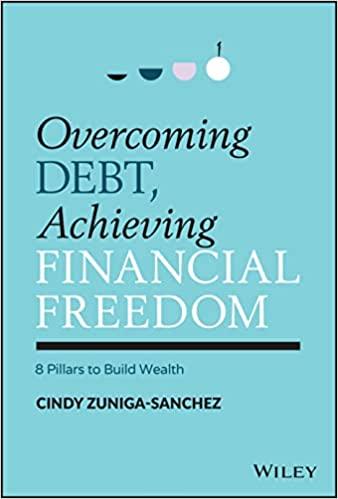Question
Must SHOW ALL WORK 1) Yield to Maturity and Yield to Call Arnot International's bonds have a current market price of $1,200. The bonds have
Must SHOW ALL WORK
1)
Yield to Maturity and Yield to Call
Arnot International's bonds have a current market price of $1,200. The bonds have an 11% annual coupon payment, a $1,000 face value, and 10 years left until maturity. The bonds may be called in 5 years at 109% of face value (call price = $1,090).
What is the yield to maturity? Round your answer to two decimal places.
%
What is the yield to call if they are called in 5 years? Round your answer to two decimal places.
%
Which yield might investors expect to earn on these bonds, and why?
I. Investors would expect the bonds to be called and to earn the YTC because the YTM is less than the YTC. II. Investors would not expect the bonds to be called and to earn the YTM because the YTM is greater than the YTC. III. Investors would not expect the bonds to be called and to earn the YTM because the YTM is less than the YTC. IV. Investors would expect the bonds to be called and to earn the YTC because the YTC is less than the YTM.
-Select-IIIIIIIVItem 3
The bond's indenture indicates that the call provision gives the firm the right to call them at the end of each year beginning in Year 5. In Year 5, they may be called at 109% of face value, but in each of the next 4 years the call percentage will decline by 1 percentage point. Thus, in Year 6 they may be called at 108% of face value, in Year 7 they may be called at 107% of face value, and so on. If the yield curve is horizontal and interest rates remain at their current level, when is the latest that investors might expect the firm to call the bonds?
-Select-In Year 6In Year 7In Year 8In Year 9Bonds are always called
2) Historical Returns: Expected and Required Rates of Return
You have observed the following returns over time:
| Year | Stock X | Stock Y | Market | |||
| 2015 | 15 | % | 14 | % | 11 | % |
| 2016 | 21 | 7 | 10 | |||
| 2017 | -12 | -6 | -10 | |||
| 2018 | 4 | 2 | 1 | |||
| 2019 | 21 | 11 | 12 | |||
Assume that the risk-free rate is 5% and the market risk premium is 3%.
What are the betas of Stocks X and Y? Do not round intermediate calculations. Round your answers to two decimal places.
Stock X:
Stock Y:
What are the required rates of return on Stocks X and Y? Do not round intermediate calculations. Round your answers to two decimal places.
Stock X: %
Stock Y: %
What is the required rate of return on a portfolio consisting of 80% of Stock X and 20% of Stock Y? Do not round intermediate calculations. Round your answer to two decimal places.
%
3) Nonconstant FCF Growth Valuation
Reizenstein Technologies (RT) has just developed a solar panel capable of generating 200% more electricity than any solar panel currently on the market. As a result, RT is expected to experience a 17% annual growth rate for the next 5 years. By the end of 5 years, other firms will have developed comparable technology, and RT's growth rate will slow to 5% per year indefinitely. RT has an 11% weighted average cost of capital. The most recent annual free cash flow (FCF0) was $1.15 million.
Calculate RT's expected FCFs for t = 1, t = 2, t = 3, t = 4, and t = 5. Do not round intermediate calculations. Enter your answer in millions. For example, an answer of $1 million should be entered as 1, not 1,000,000. Round your answers to three decimal places.
FCF1 = $ million
FCF2 = $ million
FCF3 = $ million
FCF4 = $ million
FCF5 = $ million
What is the horizon value at t = 5 (HV5)? Do not round intermediate calculations. Enter your answer in millions. For example, an answer of $1 million should be entered as 1, not 1,000,000. Round your answers to two decimal places.
$ million
What is the present value of the horizon value (HV5)? Do not round intermediate calculations. Enter your answer in millions. For example, an answer of $1 million should be entered as 1, not 1,000,000. Round your answers to two decimal places.
$ million
What is the present value of the free cash flows expected at t = 1, t = 2, t = 3, t = 4,and t = 5? Do not round intermediate calculations. Enter your answer in millions. For example, an answer of $1 million should be entered as 1, not 1,000,000. Round your answers to two decimal places.
$ million
What is the value of operations at t = 0? Do not round intermediate calculations. Enter your answer in millions. For example, an answer of $1 million should be entered as 1, not 1,000,000. Round your answers to two decimal places.
$ million
Step by Step Solution
There are 3 Steps involved in it
Step: 1

Get Instant Access to Expert-Tailored Solutions
See step-by-step solutions with expert insights and AI powered tools for academic success
Step: 2

Step: 3

Ace Your Homework with AI
Get the answers you need in no time with our AI-driven, step-by-step assistance
Get Started


